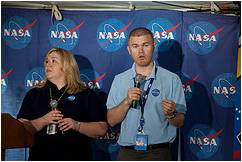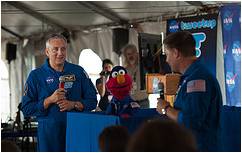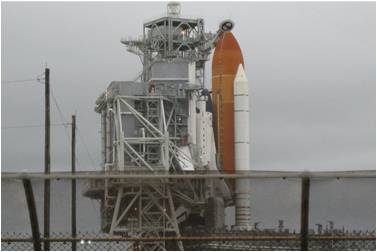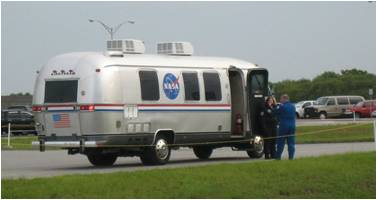This week on A Lab Aloft, comments from guest blogger Justin Kugler, Systems Engineer with the National Laboratory Office, as he recalls his experience at the STS-135 Tweetup at Kennedy Space Center, Fla.
Our mission in the International Space Station National Laboratory Office is to make the unique capabilities of the station more open to other government agencies, industry partners, and education programs. Fulfilling that mandate from Congress has introduced me to a wide variety of researchers, technologists, engineers, entrepreneurs, and educators. I have every expectation that the National Lab portfolio will only grow more eclectic with time.
As the admin for the National Lab Office Twitter account, @ISS_NatLab, it was exciting to move out from behind the keyboard and take the stage at the STS-135 Launch Tweetup at Kennedy Space Center, Fla. on July 7, 2011. Presenting alongside me was scientist Tracy Thumm with the International Space Station Program Scientist’s Office. This is a great example of how NASA has embraced the power of social media to connect with the public and share our stories.

Tracy Thumm and Justin Kugler
speak at the STS-135 NASA
Tweetup (NASA image)
Back home, our colleges with @ISS_Research supported the Tweetup and posted updates for our followers on Twitter. Tracy and I spoke about the science, technology, and exploration research planned for the final mission of the Space Shuttle Program and aboard the space station. In addition to the physical group of 150 of NASA’s biggest fans, we had countless virtual participants through the live video stream and online forums.
Some of the topics we covered for STS-135 included advanced vaccine research and the J. Craig Venter Institute’s bacteriological survey of the station environment. I also had the privilege of presenting some of the new technologies that will be broken in on the station in preparation for future deep space exploration, such as new carbon dioxide scrubbers, non-toxic propellants, inflatable modules, and advanced telerobotics.
I really enjoyed the Q&A session that followed my talk, as it allowed us to answer in greater detail how research opportunities are expanding on the station. For example, I shared a training module from a commercial partner, NanoRacks, LLC. This 10-cm cubed platform, with USB port for power and data, houses and integrates small experiments aboard the station. Using ready-made platforms like this enables researchers with a good idea, but relatively little funding to obtain sustained exposure to the microgravity environment. We also talked about the planned use of commercial lab equipment—such as a plate reader—modified for the station that will allow NASA to send data back to researchers on the ground without having to return samples. This reduces the time lag to get results.
My colleague Tracy fielded a question regarding the length of time till scientist see results from station research. In fact, we are already seeing results, such as a recently published study on the stability of pharmaceuticals in space. The International Space Station Research and Technology Website keeps tabs on the results, as they become available to the public. The actual duration for results varies from investigation to investigation.
One of my favorite questions, though, was about what we still need to learn to send humans on long-duration missions and where people can learn more. There are, relatively speaking, only a handful of data points for how the human body behaves in the space environment and billions of data points here on Earth. We understand very little of what happens in between, such as with the one-third-normal gravity of Mars. Future human research studies on the station will help us fill in those gaps so we can design vehicles and missions to keep human explorers healthy, safe, and sane on their journeys. NASA’s Human Research Roadmap covers this in much greater detail.
Later, I was told that the tent was quiet—except for the background hum of the portable air conditioners—because everyone was listening intently, taking notes for their blogs or posting our answers in real-time to Twitter. Attendees continued to come up to Tracy and I to ask questions about the work being done on the station throughout the rest of the event.
The Tweetup also included a special visit from Deputy Administrator Lori Garver and an entertaining interview between astronauts Mike Massimino and Doug Wheelock and Sesame Street star, Elmo. The Muppet, interestingly enough, had as many questions as the astronauts!

Sesame Street’s Elmo interviews
astronauts Mike Massimino and
Doug Wheelock at the STS-135
NASA Tweetup.
(NASA Image)
After the rains of that Thursday passed, the attendees all made their way out to the lawn near Pad 39A to visit the shuttle Atlantis. The crowd was electrified by the breathtaking unveiling of the orbiter, as the rotating service structure retracted from view to clear the pad for launch. Despite the amorphous grey clouds in the background, the stark contrast between the orange external tank, black and white thermal tiles on the orbiter, and the white cylinders of the boosters was truly riveting.

The rotating service structure
retracting from Atlantis
(Image courtesy of Justin Kugler)
Surprises were in store for the Tweetup participants throughout the morning of launch day. This included a visit from astronaut legend, Bob Crippen, and the introduction of Bear McCreary’s “Fanfare” for STS-135 by Seth Green (an unabashed NASA enthusiast). As the hours rolled by, the anticipation was at a fever pitch. The weather was progressively improving and everyone had a sense that the launch would actually happen.
The passing of the Astrovan further raised the level of anticipation. We had our first indication that the “final four” were close from the passing of the escort helicopter. A spontaneous cheer went up when the van and its security entourage turned the corner and came into view. There was one last stop to let off anyone not going to the pad, then the crew of Atlantis pressed on to their destination and a beautiful launch!

One last stop for the Astrovan.
(Image courtesy of Justin Kugler)
After Atlantis’ ascent, people made their way back to their laptops in the Tweetup tent or established a connection with their smartphone, the blog posts, Tweets, and picture uploads resumed en masse. Each of the Tweetup attendees became an ambassador to the rest of the world for NASA.
That relationship is what NASA Tweetups are all about. Even in the twilight of the Space Shuttle Program, the love and passion for spaceflight was alive and well in us all. I believe it is the responsibility of those who experienced the final shuttle launch—NASA employees and honored guests alike—to share this connection with the rest of the world and to look forward to the next decade of research on the space station.
The Tweetups are successful because they embody more than just telling people about what we do at NASA. Attendees have the chance to participate and share the story on their own terms. It is this bond between NASA and the public that can sustain interest in and support for our nation’s space program and future exploration. We still have a lot of work to do on the space station and to prepare for missions in deep space, so I look forward to many more Tweetups to come.

The STS-135 Launch Tweetup participants.
(NASA image)
Justin Kugler works at NASA Johnson Space Center in the International Space Station National Laboratory Office. There he supports systems integration activities for science payloads. He has a B.S. in Aerospace Engineering from Texas A&M University and a M.S. in Mechanical Engineering from Rice University.

Hi,
I’m from Telford in Shopshire,in England,i watched your launch,it was amazing,i was waiting to see you land,god bless you all,i love the space program,I hope it will continue. A*********
Thanks to you, I learned many interesting things. I hope to learn more. I congratulate you for these wonderful shares. Keep it up! ,
This is a great example of how NASA has embraced the power of social media to connect with the public and share their stories